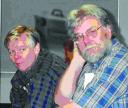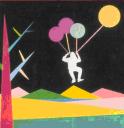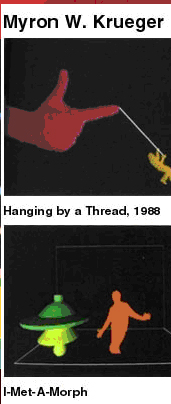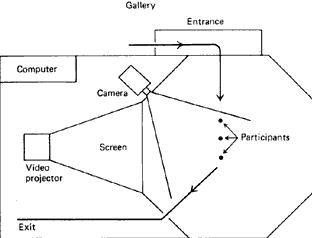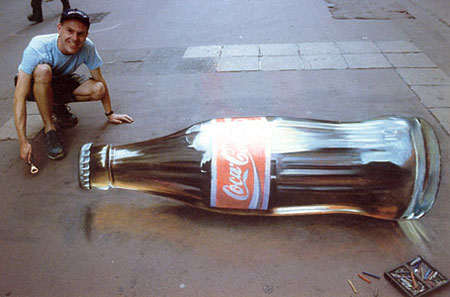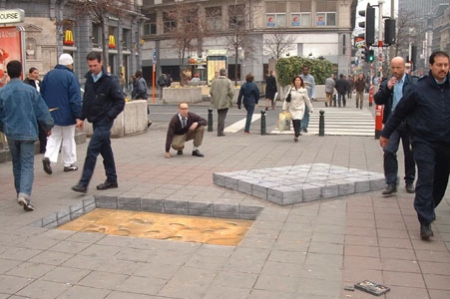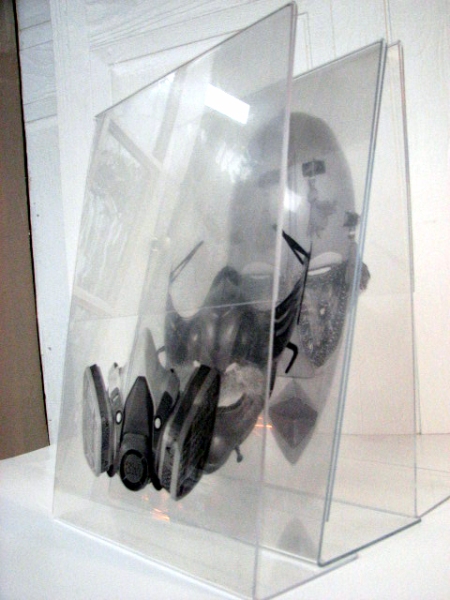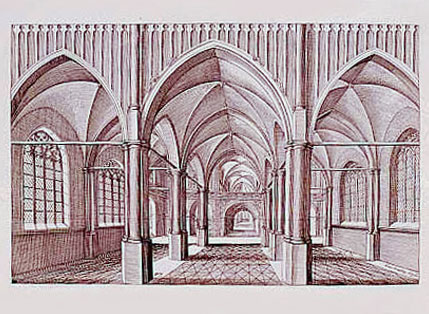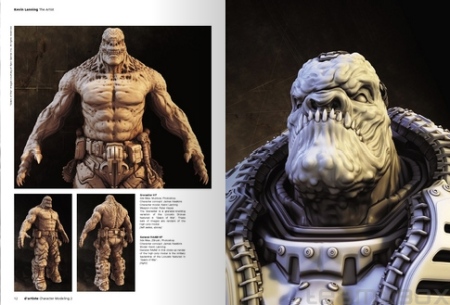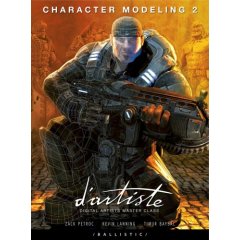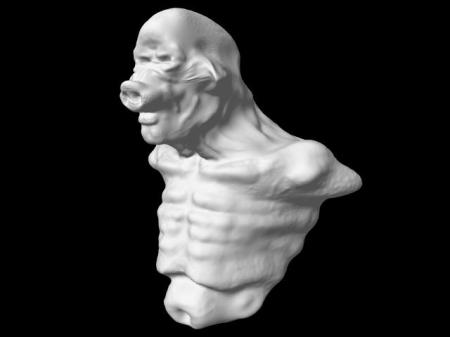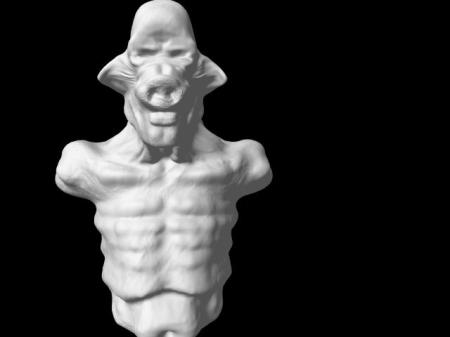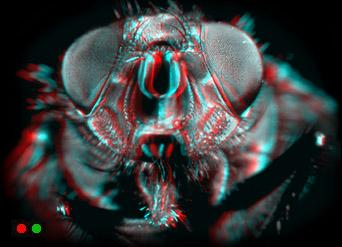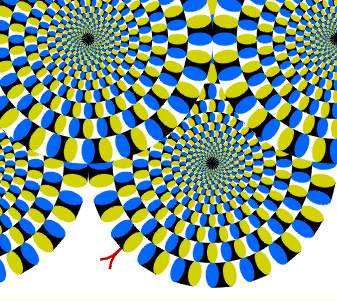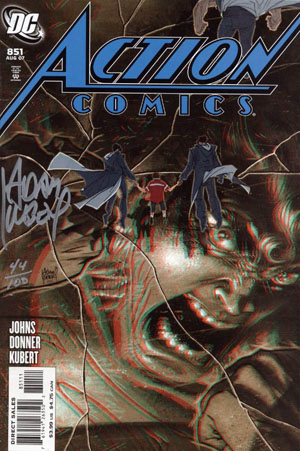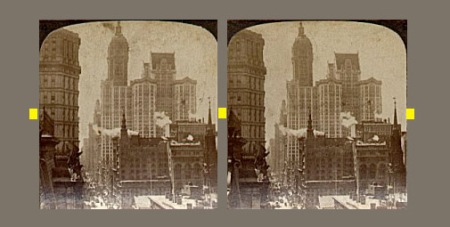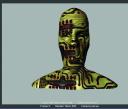Project Title: Transition
Etude Number: 1
Statement of Intention
My intention is to create a 3d environment that the user can interact with.
The interaction comes when certain objects, buildings or other aspect of the environment are selected the buildings or objects can then be morphed and changed by simply selecting parts of the object with the cursor/mouse and creating a new environment for other users to interact with at this stage you can create a social environment that provides you the opportunity to interact with others over the internet.
My intention is to create this 3d environment using a dedicated software programme Maya version 8 this would allow me to create and manipulate a 3d model for the environment.
At the development stage my intention is to sculpt and create the shapes for both the structure of the buildings and objects once satisfied I will then add photographic textures which would be taken using my digital camera.
At this crucial and initial stage I will then map the textures on to the structural shapes adding depth and feel to the theme of the 3d environment.
The purpose of the etude is to create an interactive environment that can be used on the Internet and it would be designed in such a way so that it allows the user the freedom to create their own design or sculpture
By creating multiple blend shapes using the Maya programme it allows the shapes to be morphed and changed to make new forms, there are a great many uses for example in Architecture, design concepts for art and sculptures and even for interior design concepts within the home all of these can be used depending on the theme or the environment chosen it also allows the user to have full control of his/her creativity in 3d space allowing the user to map their own images onto a variety of shapes and forms.
I will initshaly draw up design plans for structural layout then start to sculpt structural shapes and forms for the project, I will then take photographs with my digital camera and map these on to the sculptures within Maya, after this I will start to create the blend shapes.
The blend shapes will show how the user could manipulate the objects/sculptures.
TUTORIALS ON BLEND SHAPES
Digital Tutors cover how to create your first set of blend shapes. Use blend shapes to create morph targets of your character’s facial poses or muscle deformations.
http://www.digitaltutors.com/digital_tutors/video_details.php?v=164
I have used the digital tutoras befor on zbrush I find that they provide a very informative esey to follow instuctions clear to watch can be seen on DVD or downloaded file format.
YouTube – Blend Shapes controls in Maya
An example of Blend Shape
www.youtube.com/watch?v=CQ5SFhynSWU
Maya Version 8.5
Overview
Award-winning AutoDesk Maya software is a powerful, integrated 3D modelling, animation and rendering solution that enables leaders in film and television, game development, design visualization, and education to stay ahead of the game.
AutoDesk Maya 2008 software delivers faster, more efficient tools and workflows for creating the stunning, high-resolution characters, environments, and performances that will populate the games consoles, theatre screens, and televisions of the future.
New and Enhanced Modelling Tools and Workflows
Maya 2008 introduces considerable performance improvements and a number of new features that will make modelling workflows significantly more efficient. The Maya Mesh Smooth workflow, for instance, has been dramatically streamlined: You can now preview a smoothed mesh while editing the mesh cage—with superb performance, particularly on multiprocessor workstations. Other much-requested workflow enhancements include the ability to position objects along a curve, replace objects within a scene, and convert instances to objects.
Expanded Platform Support
Support for Windows Vista operating system has been added, enabling customers to take advantage of the performance capabilities of this recent technology.
The Maya Help is your comprehensive guide to learning and using all aspects of the Maya software. It is a complete online library of guides to virtually every aspect of the software that includes general information about all features of Maya, procedural information on how to perform various tasks, tutorials, and an extensive reference section.
The relevance of the etude in relation to the initial concept of the 3d Hybrid is that it contains multiple elements of photographic imagery and incorporates three dimensional sculpturing using The Maya software programme.
As a way of evaluating the etude allowing it to be taken to the next stage of development as a larger scale project, I believe that with the recourses at my disposal I would find it difficult and I would have issues with its development as I do not have the expertise or training to import this environment into a software package which I feel is necessary if it was to be used in the way of my original design concept and that was to provided a visual interactive programme.
My target audience for this project will not be restricted to any one age group and with no boundaries or constraints attached the design concept once produced will allow the user to have the opportunity to express their own individual creativity inviting them to create from their own imagination shapes and forms.
What will become apparent once the 3d Hybrid sculpture has been created is that it will allow the user to interact and manipulate the original design and change this to whatever they want it to become.
This will be achieved by creating a hybrid of photographic images which will then be mapped onto a three dimensional sculpture, once this has been created it will
By capturing photographic imagery which will then be used for textures and then mapping these onto three dimensional sculptures the intention is to produce a Hybrid of 3d Photographic designs which will be imported into an Interactive computerised programme allowing the user to have total control of being able to alter or change completely the original image to any that they feel is suitable for their requirement and along with this freedom of self expression it also gives the user the opportunity to interact with the programme and creates a relationship between the programme and the user.
The components that were used to create the etude involved initially using new technology such as a dedicated manipulated software programme Maya version 8 to create the original design sculptures The next component was Photoshop version 8 to manipulate the photographs for use as textures, the Digital camera component for taking the original photographs and an assortment of printed circuit boards to provide elements of visual concept to be used in the final design
Although this concept idea is only at the design stage I would hope that if it is taken to the next level which would be producing a prototype working model I would have to rely on other software programmes that could be used to create the interface and therefore my original idea is very dependant on whatever software is available. Companies Researched
http://www.adobe.com/products/director/3d/partners/
Who We Are
Havok is the premier provider of interactive software and services for digital media creators in the games and movie industries.
With world leading expertise in physics, animation and tools, we make it our business to turn our customers’ creative aspirations into technical realities.
Havok’s modular suite of tools gives power to the creator, making sure that our clients can reach new standards of realism and interactivity, while mitigating the overall cost and risks associated with creating today’s leading video games and movies.
We work in partnership with the world’s best known game developers – including Sony, Microsoft, Midway, EA, Ubisoft and Activision. Havok’s cross-platform, professionally supported technology is available for the Wii, PLAYSTATION 3, PLAYSTATION 2, PSP™, Xbox , Xbox 360, GameCube™, and the PC. Havok’s combination of superior technology and dedication to delivering for our customers every time has led to our technology being used in more than 170 of the world’s best known game titles, including Halo 3, Halo 2, Stranglehold, BioShock, Crackdown, MotorStorm, and many more.
Havok products have been used to drive special effects in movies such as Poseidon, The Matrix, Troy, Kingdom of Heaven and Charlie and the Chocolate Factory. Havok provides the dynamics driving 3ds Max from Autodesk Media and Entertainment.
Havok was founded in 1998 in Dublin, Ireland and has offices in San Francisco, Calcutta, Munich, and Tokyo.
About ForgeFX
ForgeFX is an interactive 3D simulation and visualization company based in San Francisco. We provide software development services for clients looking to create both online and offline interactive content. Our clients compete in the education, training, and entertainment industries.
Interactive 3D Simulations
ForgeFX creates realistic interactive simulations that give your target audience—employees, consumers, or students—the ability to learn effectively while reducing physical and financial risks. We provide custom-developed interactive simulations to our clients. Whether you are trying to educate, train, inform, or entertain, interactive 3D simulations fully engage your target audience.
What’s Special About Simulations?
It’s no secret that we learn best by doing, and therefore life—or life-like—experiences are the best way to learn. When it comes to making critical decisions, the key to success is having the experience that comes from training and practice. In the real world, acquiring this experience can be expensive, impractical, and depending on the tasks, even hazardous. Done right, simulations remove these constraints.
Competitive Advantages and Differentiation
In addition to the strength of experiential learning, there are benefits from a business perspective that interactive 3D simulations bring to the table. At the top of the list is differentiation. The internet has given people more choice than ever, making it critical that you stand out in some way from your competitors. The question is not whether, but who will be the first in your field to extend their offering with an interactive simulation or game-like experience.
With near-cinematic quality 3D entertainment experiences becoming commonplace, you need to be able to compete for your audiences’ attention. Interactive 3D simulations, in addition to their instructional effectiveness, deliver a powerful and attention-grabbing “wow” factor that should not be underestimated.
Leading-Edge or Bleeding-Edge?
Even a bargain-basement PC comes with a 3D card these days. This fact, combined with a broadband-enabled internet audience, makes deployment of interactive simulations practical for broad target audiences.
Ready to take the next step?
Whether you have a detailed project specification in hand and are looking for a vendor, or are just beginning a discovery phase exploring the advantages an interactive simulation might bring to your company,
contact us to start the discussion.
An immersive digital environment is an artificial, interactive, computer-created scene or “world” within which a user can immerse themselves.
Immersive Digital Environments could be thought of as synonymous with Virtual Reality, but without the implication that actual “reality” is being simulated. An Immersive Digital Environment could be a model of reality, but it could also be a complete fantasy user interface or abstraction, as long as the user of the environment is immersed within it. The definition of immersion is wide and variable, but here it is assumed to mean simply that the user feels like they are part of the simulated “universe”. The success with which an immersive digital environment can actually immerse the user is dependent on many factors such as believable 3D graphics, surround sound, interactive user-input and other factors such as simplicity, functionality and potential for enjoyment. New technologies are currently under development which claim to bring realistic environmental effects to the players’ environment – effects like wind, seat vibration and ambient lighting.
Artists/research/Technologies
Virtual simulation
Radiation Oncology Physics
Dr. Melvin Astrahan, Ph.D., a Medical Physicist with the University of Southern California has been developing software for virtual simulation since 1989. “RT Simulator” is one of the most advanced virtual simulation and medical imaging tools available, and is exclusively available through the USC Department of Radiation Oncology and its affiliates.
http://radonc.usc.edu/USCRadOnc/Downloadable/VirtualSimulation.html Virtual simulation is the process by which a detailed 3D model of a patient is built from a sequence of dozens or sometimes hundreds of closely spaced transverse CT (or MRI) images. Since the grey levels of the CT images are directly related to the density of tissue, the computer model can be used to calculate the image that would be produced on a piece of film by a conventional diagnostic X-Ray machine. This calculated image is called a “Digitally Reconstructed Radiograph” (DRR).
The advantage of the DRR is that it can be calculated almost instantly for any angular projection through the body. Using a mechanical X-Ray machine and film requires many minutes of setup and film developing for each projection. When planning high energy radiation treatments for cancer patients, it is a distinct advantage for the Physicians and Physicists to be able to rapidly evaluate many potential projections in order to find the ones which minimize the exposure of healthy organs to the radiation beams.
Artificial realities
Myron Krueger (born 1942 in Gary, Indiana) is an American computer artist who developed early interactive works.
Image on the left is of Myron w. Kruger en.wikipedia.org/wiki/Artificial_reality
He is also considered to be one of the first generation virtual reality and augmented reality researchers.
Augmented reality (AR) is a field of computer research which deals with the combination of real-world and computer-generated data. At present, most AR research is concerned with the use of live video imagery which is digitally processed and “augmented” by the addition of computer-generated graphics. Advanced research includes the use of motion-tracking data, fiducial marker recognition using machine vision, and the construction of controlled environments containing any number of sensors and actuators.
http://old.siggraph.org/artdesign/gallery/S98/pione/pione3/krueger.html
Artificial reality was the term Myron W. Krueger used to describe his interactive immersive environments, based on video recognition techniques,that put a user in full, unencumbered contact with the digital world.
Krueger worked on a number of early interactive computer artworks. In 1969, he collaborated with Dan Sandin, Jerry Erdman and Richard Veneszky on a computer controlled environment called “glowflow,”
GLOWFLOW is a computer-controlled light sound environment that responded to the people within it. In a dark empty room, four transparent tubes were attached the gallery walls. These had phosphorescent particles in water with each tube containing a different colored pigment.
The visual reference was provided by the lighted tubes that were arranged to distort the viewer’s perception of the room as they caused the room to appear wider in the center than at each end. Thus, as participants walked the length of the room they felt they were going downhill with respect to their own position based on the direction of the tube!
Virtual reality (VR) is a technology, which allows a user to interact with a computer-simulated environment, be it a real or imagined one.
Most current virtual reality environments are primarily visual experiences, displayed either on a computer screen or through special or stereoscopic displays, but some simulations include additional sensory information, such as sound through speakers or headphones.
Some advanced, haptic systems now include tactile information, generally known as force feedback, in medical and gaming applications.
Users can interact with a virtual environment or a virtual artifact (VA) either through the use of standard input devices such as a keyboard and mouse, or through multimodal devices such as
The simulated environment can be similar to the real world, for example, simulations for pilot or combat training, or it can differ significantly from reality, as in VR games. In practice, it is currently very difficult to create a high-fidelity virtual reality experience, due largely to technical limitations on processing power, image resolution and communication bandwidth.
However, those limitations are expected to eventually be overcome as processor, imaging and data communication technologies become more powerful and cost-effective over time.
http://images.google.co.uk/imgres? www.osc.edu/…/projects/wheelchair/index.shtml
Immersive environments
An immersive digital environment is an artificial, interactive, computer-created scene or “world” within which a user can immerse themselves.
Immersive Digital Environments could be thought of as synonymous with Virtual Reality, but without the implication that actual “reality” is being simulated.
An Immersive Digital Environment could be a model of reality, but it could also be a complete fantasy user interface or abstraction, as long as the user of the environment is immersed within it.
The definition of immersion is wide and variable, but here it is assumed to mean simply that the user feels like they are part of the simulated “universe”.
The success with which an immersive digital environment can actually immerse the user is dependent on many factors such as believable 3D graphics, surround sound, interactive user-input and other factors such as simplicity, functionality and potential for enjoyment.
New technologies are currently under development which claim to bring realistic environmental effects to the players’ environment – effects like wind, seat vibration and ambient lighting.
The creative side of second life
In the Second Life world you can create anything you can imagine with powerful, highly flexible building tools, using geometric primitives and a simple, intuitive interface. Build live, in real-time, right in Second Life – no separate tools or applications to buy or learn and no hassles with importing your work. Building is easy to learn, yet robust enough to inspire your creativity.
The Second Life world is a place dedicated to your creativity. It’s about dreaming of something one moment and bringing it to life the next. Everything in Second Life is resident-created, from to the strobe lights in the nightclubs to the car (or spaceship) in your driveway.
So far after examining second life I found it very interesting and shows that people how play or participate can be addict to this as there are no limits or boundaries within this digital world it provides a full emersion within.
Allowing you to become some one else play different roles basically live a different life.
The original concept idea has been developed incorporating a theme for the environment that is based on surrealism, with no real purpose intention or thought simply experimentation using the creative and manipulative tools with the Maya programme which enabled me to create a variety of structural shapes which were later enhanced with photographic textures using Adobe Photoshop
Documenting my process of creation
To provide a visual reference and documentation of my progress I captured screen shots of stages of development ensuring continuity these provided an opportunity to review the different stages.
See below
(A) This screen shot captured using Maya version 8 reveals how I initially created the base for the environment at stage one I went to Create then stage two I selected polygon primitives and then at stage three selected plane which allowed me to create the base.
(B)
(B) :This screen shot captured using Maya version 8 at stage one I selected Creating the Sculpture at stage Two I selected the Mesh Create Polygon tool and using this tool I began drawing the basic shape of the sculpture I then saved the work and prepared for the next stage.
(C)
(C) This screen shot captured using Maya version 8 shows that at this stage you have achieved the basic shape at stage one I selected the Polygon face and press the extrude button which allows you to manipulate and pull sections of the shape out which then creates from the polygon shape a solid three dimensional sculpture.
(D)
(D) This screen shot captures using Maya version 8 shows that at this stage I selected the cutting face tool which allowed me to draw around the shape using point of reference directly onto the polygon shape and selecting the enter button divided sections that can be later extruded.
(E) This screen shot using Maya version 8 shows that at this stage I add the correct number of points I saved the project and then entered into the next stage beginning to extrude and pushing sections into the sculpture using my imagination to create a shape 5.
(F)
(F) This screen shot using Maya version 8 shows that at this stage I used the mouse cursor and right clicked which allowed me to select the Versity which allowed me to manipulate and move point of the object creating a different shape and then selected the scale tool which allowed me to enlarge certain areas of the sculpture
(G)
(G) The screen shot using Maya version 8 shows that at stage one I began to create the Blend shapes which reveals the object changing shape using the buttons and control system to achieve this I first had to duplicate the original sculpture and then make changes to this design I then saved the work at proceeded to stage two at this point I selected the copy that I had already made and at the same time selected the original then go to deform then create blend shapes.
(H)
(H) In this screen shot using May Version 8 it shows that all the blend shapes have been created and the work saved the next stage was to smooth the shape and once satisfied I began to add the photographic textures which had already been captured by using my Digital Cannon Powershot camera onto the sculpture.
Examples of buttons
Right click and press assign new material to object.
Examples of buttons
I then added the bump map to give depth to the shape and sculpture.
Technical Analysis
The very basic concept of a technical analysis is to study the supply and the demand of the product in the market place and be able to determine the direction or trend and how it will continue in the future.Before creating the Etude I recognised that by designing a component that allows the interaction between the user and the design it provides a closer and more positive way of creativity and could be used in a great many diverse applications in the market place from design concepts for houses to basic sculptural designs.The long term projected popularity of such a concept is perhaps its strongest asset The resources used to create the original concept design of my etude consisted of several different software programmes these were Autodesk Maya version 8 which with its considerable array of tools and features not least of which is the ability to position objects along a curve and replace objects within a scene allowing workflows to be significantly more efficient, Adobe Photoshop 7 with its diverse and uncomplicated tools allowing control and edit facilities for photographic imagery and to be able capture the images I used a Cannon Powershot S3is 6.0 mega pixels digital camera.
The technical advances achieved during the creation of my etude provided the framework for future projects I discovered the importance of attention to detail applying my own creativity to the design the use of dedicated programmes how important it is to explore other ways and methods of creation and using new technology and identifying which programmes can be used .
By experimentation with these different programmes I have gained a wider and broader technical knowledge of how to use the tools within these programmes which can be carried forward to the next project.
My Artistic explorations and research has helped me to appreciate and understand other methods of interaction within a 3d interactive environment by examining other programmes and artists I can now appreciate the complexity and difficulties that would be involved if I decided to take my etude to the next stages of prototype and perhaps to the final stage of production
As an example of my research I examined Second Life an interactive software programme which uses a 3D virtual world entirely created by its residents. since opening to the public in 2003, it has grown explosively and today is inhabited by millions of residents from around the world.
From the moment you enter the World you’ll discover a vast digital continent, teeming with people, entertainment, experiences and opportunity. Once you’ve explored this world, perhaps you will find a perfect parcel of land to build your house or business.
You will also be surrounded by the creations of your fellow residents. because residents retain intellectual property rights in their digital creations, they can buy, sell and trade with other residents.
The conceptual problems experienced during the first stages of my conceptual design became evident almost immediately I realised that I did not have the experience or the programme knowledge to be able to take the original idea to prototype stage however to design an etude as a concept idea it was necessary to examine my own ability and the creation solution to completing the etude design was very much based on the fact that I was able to apply my own limited knowledge that I had gained from past experiences along with my creative imagination and this provided the framework for completing the etude.
Technical problems encountered during the original creation of my etude were the difficulty of texturing 3d sculptures and importing these sculptures into the environment the creative solution was achieved by experimenting with different options within the Maya programme and discovered that by selecting preferences and changing the textures from projection to normal mapping allowed me to texture the map correctly.
As a way of self reflection I feel that I have created an etude from an idea that was based originally from photographic imagery and with limited knowledge of programmes I have achieved a design that could be used for a great many different applications within the market place.
I feel that I have achieved the original brief and by using a variety of programmes along with my own imagination I have created a concept idea and transferred this to the stage of becoming an etude however probably due to lack of expertise or knowledge of programmes available I would not be able to take the design to the next level for prototype or production.
ID: 20008769
NAME: Richard COUNSELL
3D HYBRID
Project Title: Perception
Etude Number: 2
Statement of Intention
Initially my intention is to create and design an etude that will show an example of perspective imagery that visually can give the illusion of a 3 dimensional space and at the same time give perception of depth using photographic imagery.
To create the etude I will be using digital photography to capture still images Adobe Photoshop for their manipulation and then printing these images onto specialised material and designing a layout for presentation
Conceptualisation of Work
The purpose of the etude is to create an art piece that by its design gives the illusion that it can be perceived as a three dimensional image it provides a visual perception of what the design could look like with or without all of its components and to achieve this the design uses a hybrid of techniques to create the final concept.
The design uses a linear perspective displayed as three-dimensional images onto a two-dimensional surface.
The relevance of the etude to the initial conception when examined reveals that the original idea of the concept has remained unchanged however, there were minor issues with the type of materials that could be used to display the photographic imagery and by experimentation with a variety of different media I discovered that by using sheets of acetate this allowed me to display several images in such a way that they could easily be perceived at the same time as coming together as a single three dimensional form.
The relevance of the etude to issues of the module and to the larger project when examining these issues it is noticeable that by the design of the module in this case my design showing a form of 3d hybrid using Photographic imagery presented in such a way so that it creates a visual illusion of becoming three dimensional.
If the design module was taken to the prototype stage which is considered the next level prior to production then I would consider that it would be necessary to experiment with an array of different mediums which could include amongst many Photographic imagery, three dimensional sculptures and 2d designs all of which could be used as a way of creating within an image depth and by creating this design by using a hybrid of different techniques it could be used or applied in a great many different applications which could include technical drawings architecture plans art pieces and where ever the imagination requires something to be presented as a three dimensional image revealed on a two dimensional platform.
When examining the use and design of this etude and deciding on its target audience if the design was taken to the next level which is the prototype stage then once produced it could be used for a variety of applications and by companies that could include amongst its users Architectural and Industrial providing these companies an opportunity to show a three dimensional image or design as a graphic layout demonstrating how particular designs and concepts would look at the final stage of its design.
This image taken from the Murray web site shows a form of three dimensional transparencies with multiple layers demonstrating an engineering construction design image which gives depth within layers and visually allows you to see the complete end creation.
http://www.murraystate.edu/iet/egd_
To examine the relationship between the subject and the content of the etude I considered that it was necessary to research how perspective art is being used by artists to create by perception an illusion.
I looked at the work of an English artist Julian Beever who specialises in presenting 2D pavement art that looks as though it is 3D when viewed from a different perspective
This type of art stimulated my own imagination and formed the basis of an idea which could be used to create my own art piece an etude that would show 2D imagery presented in such a way and on medium that when perceived appears as though it is a three dimensional image with depth and giving a visual perception of space.
An example created by Julian Beever
Julian Beever is an English artist who is famous for his art on the pavements of England, France, Germany, USA, Australia and Belgium. Beever gives his drawings an anamorphosis view; his images are drawn in such a way which gives them three dimensionality when viewing from the correct angle.
Anamorphic illusions drawn in a special distortion in order to create an impression of three dimensions when seen from one particular view point.
http://users.skynet.be/J.Beever/pave.htm
To carry out an analysis of the separate components within the etude it was first important to examine how perception and depth could be used to create my own design for the etude.
Through my Research I examined different methods that were being used by other artists an example of which is the art created by the artist Julian Beever.
As a way of using the illusion of depth and space I examined perspective art which shows how an image when drawn onto a flat surface as a two dimensional design can also be perceived as a three dimensional image depending the medium used and the way that the design is visually presented.
The two most characteristic features of perspective are that objects are drawn:
Smaller as their distance from the observer increases
Images may be two-dimensional, such as a photograph, screen display, and as well as a three-dimensional, such as a statue. They may be captured by optical devices—such as cameras, mirrors, lenses, telescopes, microscopes, etc. and natural objects and phenomena, such as the human eye or water surfaces.
The word image is also used in the broader sense of any two-dimensional figure such as a map, a graph, a pie chart, or an abstract painting. In this wider sense, images can also be rendered manually, such as by drawing, painting, carving, rendered automatically by printing or computer graphics technology, or developed by a combination of methods, especially in a pseudo-photograph.
An example below shows a 2D design of a kitchen layout displayed as a 3D point of view, creating depth and perception through concept design.
www.here.com.au/bdk/drawings.htm
The relationship between the virtual work and the response shows that the design of the etude stimulates the imagination of the user allowing it to be visually perceived not only from a variety of different angles of perspective but also allowing the design to be perceived as a three dimensional image created initially as a two dimensional concept design.
The versatility of this concept design and the many different ways that it could be used as a way of presenting in the future shows that its concept idea could establish itself and form a relationship between both the virtual work and the response that it achieves.
When considering the user experience I would hope that the design would stimulate the imagination and would allow the etude to be presented as a three dimensional image giving it a depth in space accompanied with an interaction by the audience this would be achieved by allowing them the freedom to view the art piece from different perspectives and having full control as to what part of the object they viewed at any one time.
The main mode of interaction is to present visually a perspective image that by its design presentation creates a platform that provides an opportunity for the audience to view the subject from different perceptive angles.
These 3D imagery designs mean that you do not have to rely on a huge measure of personal imagination as to what the appearance of the finished design will become.
Documentation of Technical and artistic process.
Technical Analysis.
To create the etude I used a variety of different recourses the first stage was to capture photographic images by using a Canon Powershot Si3 digital camera using an SD card and transferred these captured images through an USB device onto my computer and into Adobe Photoshop version 7 a photographic manipulated software programme, at this stage I then changed all of the images from their original colour into greyscale this would allow me to create continuity within the captured images.
As a way of trial and error I experimented with different types of medium which I would be using as a way of presenting the captured manipulated images and discovered that by using acetate clear plastic sheets with a 130 gram weight it would be possible to print my captured images in such a way that they could appear transparent and if viewed together they would appear and a create a singular design
The most significant technical advance in the creation of the etude is that by experimenting with a variety of medium I have discovered that by using acetate rather than clear plastic or tracing paper allowed me to create different independent clear transparent images which when presented as layers and viewed from a particular angle could form a singular image.
Through research the Artistic explorations that I have made have allowed me to understand and see how other artist have used depth and space in their art, this can create an allusion of three dimensional forms.
What has become apparent is that there are a great number of artists using the perspective of illusion within their design concepts.
An example of Perspective Art
Hans Vredeman de Vries’s ‘Art of Perspective’ (published 1604 – 1605)
Perspective. Smithsonian Modern Art Sculpture Garden
When examining the creative solutions relative to the conceptual problems it became clear that although the use of acetate provided the right medium for printing and for allowing the design to have a form of transparency I discovered that the material itself was lightweight and flimsy and because of this factor the acetate was unable to support itself in the vertical position.
The solution to this conceptual problem was to use a similar size of plastic Perspex sheet which stood upright by using a small stand and by attaching the acetate sheet with the design to the rigid plastic it allowed the acetate and its design to be viewed in the vertical position and with several aspects of the same image could be placed in such a position behind each other to allow the transparent images to form together as one singular main photographic image.
The original concept was to use a wooden frame with the acetate sheet attached and show the design through several similar wooden frames.
However By using a frameless Plastic sheet it provides maximum visual areas for perception of the image see both the original concept design and the design that will be used to mount the images.
Image of original Frame to display Acetate Image.
ID: 20008769 NAME: Richard COUNSELL
3D HYBRID
Project Title: Bioethic Creation.
Etude Number: 3 Statement of Intention
My intention is to create a three dimensional hybrid sculpture that uses in its design an influence of Bioethics and once created I will present this hybrid sculpture in a way that its design and concept invites a reaction from the audience.
The initial design will be created by using images of both human and animal form because Bioethics is the philosophical study of ethical controversies which are brought about by the advancements in biology and medicine I anticipate that when viewed as an image of joining together of human and animal form it will invite a reaction of comment.
The design of the etude will be created by establishing points of reference with other artists who have used Bioethics in their own designs and works of art and by further examining their art work and concept ideas this may help influence the design of my own creation.
At the concept stage I will experiment by drawing several different designs and by careful selection decide on the designs that may form the basis for the etude and will be later transformed into a three dimensional hybrid sculpture.
I believe that by creating my concept design using the human and animal form to make that sculpture and incorporating it as a 3d hybrid image with a bioethic influences I will be creating a unique and entirely different singular image, although maintaining some characteristics of the original it will now be perceived visually as an image that appears to be taken from a living entity and as such may be entirely controversial as it crosses the accepted boundaries of being ethical.
Conceptualisation of Work The purpose of the etude is to create a design that when viewed would invite and at the same time stimulate controversial questions to be asked as to its relationship with life science medicine and theology and whether the concept is ethical in today’s society.
Ancient Greek mythology mentions monsters such as Minotaur described as a man with a bulls head and the centaurs a mixture of human form and horse and today the practice of human animal mixing has invited controversial and ethical questions the report of human and animal mixing is fast becoming a reality rather than fantasy and the progress of science and future technological advancements have opened the doors for new and perhaps disturbing possibilities for the future.
By visually presenting an etude with a subject matter so controversial it stimulates and invites a reaction.
The relevance of the etude to the initial conception can be easily identified as it is based on designs of art work created using Bioethics using human and animal forms and identifies itself with my original idea for the conception for the creation of the three dimensional hybrid sculptures.
An example of a design used and created as a hybrid art piece by an Australian artist Patricia Piccinini who has often described her art as specious distinctions between the artificial and the natural and as a statement often challenges our classification of life by displaying the relationship and difference between organic, natural and our constructed material world this inspires her to combine human physiology and technological development.
Examples of her works of art can be seen at the Frye Art Museum in Seattle Washington North America.
The relevance of the etude to issues of the module and to the larger project by examining these issues I would consider that if the concept design of the etude was taken to the next level which would be the prototype model I would then add much more detail to the sculpture and would integrate into the design more distinctive elements of human form and by presenting a visual concept with an example of a hybrid image of human and animal anatomy fused together appearing as a complete
entity and by its appearance it would show that both images animal and human maintained their own individual inherent characteristics but now blended together as one singular image could be interpreted as something with an entirely different meaning.
It is anticipated that by creating this sculpture it will evoke a reaction.
The imagery would then be taken to Adobe Photoshop version 7 and at this stage I would create and enlarge the image and adding effects which would make it appear as though it was an actual photographic image taken from real life.
When considering the target audience and relative to the controversial subject of my design I believe that it might be considered disturbing and unsettling as it shows the blur between the boundaries of human and animal in such a lifelike visual experience.
To appreciate this experience I feel that you have to accept that in the future the technology will be available to create this type of entity whether this is ethical is open to debate but I feel it will always be controversial.
To be able to examine the relationship between the subject and the content of the etude I considered that it was necessary to research and examine other artists who have used and created similar controversial designs as an example Zack Petrock an accomplished artist who has produced some amazing three dimensional sculptures and art work some of which is shown in the publication D artiste Character modelling for digital artists his designs attempts to define the aspect of hybrid using the thought of what a mythological character embodies as a starting point, he found an appropriate and modern twist to the principle of genetically engineered creations.
This type of art stimulated my own imagination as I considered that the subject matter could be interpreted in so many different ways and by examining examples of this type of art helped me to consider several ideas that I felt I might use to create my own art piece which would take the form of an etude showing a realistic manipulated design of a 3d hybrid sculpture.
To carry out an analysis of the separate components within the etude I initially examined different images and compared which image could be joined with another to create a visual concept of producing a 3d hybrid design combining Human and animal form.
To analyse each component I began by researching the background and history of genetics and examined the work of Gregor Mendel who in the nineteenth century maintained that there was an inheritance of acquired characteristics revealing the belief that individuals inherit traits that were evident in there parents.
I then examined Mutations and how these can have an impact on the phenotype of organism and by changing from what they are to something different produces an image entirely different.
This background research provided a brief insight into how by using mutated or genetic engineering it can produce an entirely different entity.
But there was always the controversy associated with such creations and I reviewed several publications and reports one of these was the report on Human and animal mixing carried out by the Scottish Council of Human Bioethics and world science staff in August 2006
Within that report it states clearly that Scientist are going to far in creating mixed human and animal organisms, maintaining that crossing the human species barrier is a procedure that had always fascinated humanity but will always be controversial .
The relationship between the virtual work and the response shows that the design of the etude stimulates the imagination inviting comment perhaps due to its controversial design aspect and it is considered by many to be a sensitive subject and one that they prefer to dismiss without serious consideration.The final design of the etude will encourage a response by inviting it to be visually examined and by presenting the image as a 3d hybrid it extends over the boundaries of what are considered acceptable in the world of today.
I believe that the spectator when examining the sculpture will immediately be engulfed in a dilemma unsure of what boundaries have been crossed and ethically questioning whether this creation exceeds what is acceptable in today’s world.The design opens the door for new concepts and ideas but at the same time is controversial inviting debate as to whether this joining of human and animal is ethically correct.
The relationship between what is being observed and the spectator indicates that because of the subject’s controversial design it invites comment.In today’s world the reality of using hybrid embryos created using the shell of an animal embryo with adult human DNA added could help address a shortage of human embryos for research.The recent debate reported in the Daily Mail in March 2008 shows that there is a revolt by many Members of Parliament and by the general public when considering the ethical motives of using embryo research. It would seem that what once was considered fantasy might now become reality and what was once controversial might one day becomes an accepted practice and because of this I presume that the boundaries of what is ethical are being moved in a different direction.
Technical analysis
The very basic concept of a technical analysis is to study the supply and the demand of the product in the market place and be able to determine the direction or trend and how it will continue in the future.
Before creating the Etude I recognised that by creating a design that invites comment and by its very existence is controversial will always stimulate a reaction. The long term projected popularity or controversy that it invites is perhaps its strongest asset
During the initial stage of the development of my etude I recognised the importance of identifying and determining what resources I could use either as a physical or virtual entity to create my design.
I researched several publications and art books that contained information and examples of art created by Artist that have used similar 3d hybrid and creature designs by using a variety of methods and techniques one such artist was Kevin Lanning who showed a depth of imagination in some of his art work, he was responsible for creating 3d models for the epic game of Gears of War and although examples of his art could be considered bizarre it provided an interesting insight into what can be designed using your own imagination.
Continuing with the resources used I researched the Internet for information about other artists during this exploration of Artists I discovered that there were a number of imaginative artists who have created art work using a mixture of Hybrid and physical sculptural designs within their own art work as an example Andrew Scott a sculptural designer who was renown for creating weird and bizarre pieces of art and Taron Baysal who uses the concept of integrating organic and mechanical themes into his individualistic style of art.
Both artists have produced outstanding art work and examples can be seen in the publication Character Modelling 2 by D artiste published by Ballistics.
At stage one I designed several free hand drawings and concepts using the traditional method of pencil and paper this provided a way of determining the nature of what my design would look like before taking them to the next stage which would involve scanning the designs into the computer creating a reference which would enable me to use digital manipulation techniques to create a digital three dimensional sculpture from the original 2d design. By using Autodesk Maya 8 an award-winning programme that offers a powerful, integrated 3D modelling, animation, effects, and rendering solution enabled me to use and implement my own creative imaginative ideas and apply these to the concept design.
To create the etude I used a variety of software programmes which included Z Brush version 3 which gave me access to unparalleled power and control in creating my concept design the programme further extends the creation experience by harnessing technology and providing a multitude of creation-enhancing tools.
I then entered the next stage of development and used the resource of Adobe Photoshop 7 which I used to alter and manipulate the images adding filters and effects this programme was developed and published by Adobe Systems and is a premier
image-manipulation package.
Photoshop’s primary purpose is directed towards image editing and to that end; version 7.0 adds two interesting tools to its image-editing arsenal. One of these is the Healing Brush makes quick and seemingly magical work of erasing wrinkles, minor skin defects, and other small flaws.
To create the design I used a Wacom Intuos 5 graphic tablet A 4 size which offers an ergonomic and accurate way to work on a computer the grip pen produces an efficient way of translating your own imaginative expression into a design or drawing.
Because of the flexibility in its use the Wacom Tablet can be used in different applications and gives you greater control of what you could create.
Technical Advances.
When examining what Technical advances have been made during the creation of my etude I believe that by exploring and experimenting with a variety of tools and applying different techniques to my original design this has allowed me to produce a more interesting and detailed work of art and by using equipment for example the Wacom Tablet has given me the opportunity to experiment by using different applications and because of its ease of use has given me more control of my concept design.
Created solutions to Conceptual problems.
During the initial stage of creating my concept design I considered that the drawings that I had created would provide me with the platform for creating my etude using digital manipulation and software programmes however It became apparent that at this stage I became aware that the original drawings when taken to the three dimensional modelling stage of development were not distinctive and did not show clearly the three dimensional hybrid features and lost quality becoming bland and visually uninspiring.
The solution to this problem was to completely re-design and sculpture an entirely new image making the elements of the hybrid much more distinctive within the three dimensional sculpture.
Solutions To Technical Problems. During the creation of my etude my intention was to paint and add elements of colour to the sculpture using the Z brush programme but as I did have the knowledge of how I could use the tools this limited my creative ability to overcome this problem I experimented and by trial and error discovered that I could apply some tools to the image improve its design although there was much more that I could have done if I had been fully conversant with the Z Brush programme.To take advantage of this I would have to consider involving myself in a course of tutorial to learn how to use tools in Z Brush. What I also discovered was that the quality of rendering appeared somewhat grainy and blurred to overcome this problem I used the solution of exporting the image back into Maya and at this stage changed the preference to a stronger resolution to render and by changing this option allowed me to create a much more distinctive and clear image with little or no grain effect.
Web Sites
http://jacgoade.blogspot.com/2007/10/patricia-piccininis-hug-exhibit.html
http://www.world-science.net/othernews/060808_chimera.htm
monsterbrains.blogspot.com/2007_04_08_archive…
http://beinart.org/modules/Word-Press/2007/05/06/patricia-piccininis-anthropomorphic-sculpture/
http://www.digibio.com/cgi-bin/node.pl?nd=n3
ID: 20008769
NAME: Richard COUNSELL
3D HYBRID
Project Title: Stereogram.
Etude Number: 4 Statement of Intention
My intention is to create and an etude that uses the influence of the design of a stereogram.
Initially I will create a three dimensional sculpture which will be changed into a stereogram, this etude will visually create an optical illusion giving depth and space to a 3D rendered flat image.
The hybrid sculpture once created will be presented in a way that its final concept will invite the viewer to focus his or her eyes on the image to create the optical illusion of being three dimensional and having depth, space.
The initial design will be created by using multiple images of a three dimensional sculpture and once these images have been rendered will become a flat two dimensional image at this stage I will create a stereogram which visually would show two differing perspectives of a single image. When viewed each point in the image will be shifted slightly to create the illusion.
The philosophical study of stereogram where brought about by the advancements of one artist Charles Wheatstone in 1838 he constructed the first stereoscope based on a combination of prisms and mirrors to allow a person to see 3D images from two 2D pictures.
I anticipate that when the etude is viewed the image will join together as one singular perspective. The design of the etude will be created by establishing points of reference with other artists who have used stereogram in their own designs and works of art and by further examining their art work and concept ideas this may help influence the design of my own creation.
Conceptualisation of Work
The purpose of the etude is to create and design an art piece that when viewed would create an optical illusion of depth and three dimensional space the images would be made as a two dimensional flat image.
And at the same time when viewed stimulates and creates a form of 3d perspective imagery.
http://www.perret-optic.ch/stereograme-3d/stereograme_3d_f.htm
The progress of science and future technological advancements in photography has opened the doors for new possibilities for different ways of creating free dimensional space.
The relevance of the etude to the initial conception can be easily identified as it is based on designs of art work originally created by using a stereogram concept.
This concept is evident throughout the project and forms the bases for its design as it visually allows the interpretation of an illusion of space and depth
visual illusion created by Akiyoshi KITAOKA who is an Associate Professor of Psychology at the Department of Psychology, College of Letters, Ritsumeikan University, Kyoto, Japan.
What is visual illusion? Stare at the disks below that consist of yellow and blue stripes. Each disk appears to rotate spontaneously. This work is called “Rotating snakes” created by Akiyoshi.Then stare at the two rings below the disks. The rings of blue letters appear to rotate slowly. The right one rotates clockwise, and the left one, counterclockwise. When you see an object, it appears to be right. However, sometimes it appears to be wrong i.e. things such as parallel lines not appearing to be parallel, a certain color looking like another color, or a stationary object appearing to move. We call them “visual illusion.”
http://www.kanzen.jp/trick-eyes/indexe.html
The relevance of the etude to issues of the module and to the larger project by examining these issues I would consider that if the concept design of the etude was taken to the next level which would be the prototype stage I would then design and create a much larger scale of a three dimensional sculpture.
It would then be necessary to take this sculpture to a specialist hologram Portraits Company an example could be the Spatial Imaging Ltd. In Richmond-Upon-Thames, Surrey, England this company specializes in creating images using multiple types of holograms and laser holography, white light reflection holograms, laser transmission holograms and holographic stereogram.
The main body of my idea if it was taken to the next level which would be the prototype stage is to use my three dimensional sculptural design to create a holographic stereogram portrait and to record and document the development stages as it’s being created.
This will provide important reference material for any future creations or designs.
http://www.portraits.co.uk/stereo.html
An example of The Spatial Imaging Company
Spatial Imaging was formed in 2007 the company has specialised in the production and application for promotional holograms and lenticular photographs to the highest security bank note holograms, from the latest digital hologram mastering systems to 3d television displays and from holographic portraits to architectural installations, spatial imaging has conducted business in all areas of three dimensional imaging.
How the hologram is made
The recording of a hologram portrait is very similar to having your photograph taken at first you will be asked to sit in spatial imaging special portrait studio whilst a holographic exposure is made. The recording of a master hologram takes only a fraction of a second much like a flash photograph. The master hologram is then developed, this will take a further 30 minutes, after which, you can see the amazing results. The whole process may take up to one hour you will then have a perfect three dimensional replica of your face locked forever in a piece of glass. The next stage of the process is to make a hologram print from the master hologram. This is produced in another laser studio and will take a further three days four the final hologram print.
Holographic stereogram
Holographic stereogram dose not record a portrait directly but utilises a combination of holographic and conventional 3d stereo photographic techniques to produce the final three dimensional portrait images.
These stereo photographs are shot using a digital video camera system called VIP system (video imaging with parallax) which has been special developed by spatial imaging. To record the sequence of digital stereo photographs a computer controlled camera is moved past the person on a 2 metre long track. As it moves the camera captures up to 400 images from many different points of view.
Through this process the stereogram displays a correctly coloured image but only from a certain angle. Holographic stereogram are made on a reflective material, either mirrored glass or solid metal, and front illuminated. In both instances a conventional low voltage spot light can be used to illuminate the holographic stereogams.
What is a 3D stereogram? To put it simply – a flat two-dimensional image viewed in such a way that it produces a three-dimensional effect. The objects we encounter every day are three-dimensional – that is to say, they have height, width and depth. A graphical representation of the object in the form of a painting or photograph is only two-dimensional; however, by cunning use of angles and shadows it is possible to give the portrayed object the illusion of possessing three dimensions. As early as 15,000 BC, man has endeavored to add a third dimension to his paintings by means of natural textures on cave walls. Thanks to today’s technology – which combines computers with artistic flair – a three-dimensional object may now be convincingly rendered upon a perfectly flat piece of paper.
http://www.bbc.co.uk/dna/h2g2/A2554445
When considering the target audience and relative to the subject the stereogram design has been used in a great many different applications an example would be for amusement, including “3D” movies using anaglyph motion pictures, posters and books they also can be used for a more practical uses of technologies an example could be for Clinical uses, Mathematical, scientific engineering, and Space exploration.
http://en.wikipedia.org/wiki/Image:Home_plate_anim.gif
To be able to examine the relationship between the subject and the content of the etude I considered that it was necessary to research and examine other artists who have used or created a similar stereogram designs as an example ray zone who is an accomplished artist and has produced some amazing three dimensional comic books publications and covers using effects and works of art some of his work are shown below as an example.
To carry out an analysis of the separate components within the etude I initially examined several different types of a stereogram and explored different methods of the way that had been created.
I had to analyse each component separately I began by researching the background history of works of Charles Wheatstone who was responsible for inventing the Stereoscopy, a form of stereoscopic imaging or three-dimensional imaging which uses any techniques that are capable of recording three-dimensional visual information or creating the illusion of depth in an image.
The illusion of depth in a photograph, movie, or other two-dimensional image is created by presenting a slightly different image to each eye. Many 3D displays use this method to convey images. It was first invented by Sir Charles Wheatstone in 1840.
Stereoscopy is used in photogrammetry and also for entertainment through the production of stereograms. Stereoscopy is useful in viewing images rendered from large multi-dimensional data sets such as are produced by experimental data. Modern industrial three dimensional photography may use 3D scanners to detect and record 3 dimensional information. The three-dimensional depth information can be reconstructed from two images using a computer by corresponding the pixels in the left and right images. Solving the Correspondence problem in the field of Computer Vision aims to create meaningful depth information from two images. Traditional stereoscopic photography consists of creating a 3-D illusion starting from a pair of 2-D images. The easiest way to create depth perception in the brain is to provide the eyes of the viewer with two different images, representing two perspectives of the same object, with a minor deviation similar to the perspectives that both eyes naturally receive in binocular vision. If eyestrain and distortion are to be avoided, each of the two 2-D images preferably should be presented to each eye of the viewer so that any object at infinite distance seen by the viewer should be perceived by that eye while it is oriented straight ahead, the viewer’s eyes being neither crossed nor diverging. When the picture contains no object at infinite distance, such as a horizon or a cloud, the pictures should be spaced correspondingly closer together.
http://en.wikipedia.org/wiki/Image:XEyeStCdNYCSmall.jpg To view the crossed-eye view shown here, the viewer should move slightly back from his or her normal viewing distance and place his viewpoint on a line perpendicular to the center of the image. A finger should be placed halfway between the eyes and the image, then the finger should be viewed. The three bright spots between the pictures should become four spots, and the two images become three. If the focus of the eyes is now allowed to drift to the surface of the screen without uncrossing the eyes, a three dimensional depth illusion will appear in the central image. The finger may now be removed from the view. A viewer may find that the extra side images become unimportant once in-depth view of the central image is stable. The relationship between the virtual work and the response shows that the design of the etude stimulates by its visual interpretation the mind and perception through optical illusions, creating your own virtual response to what is perceived.It encourages you to question if the image is moving or three dimensional and to doubt your own visual concept of what you know can not be real
I believe that the spectator when examining the stereogram will be immediately engulfed in a personal dilemma as they will be placed into a situation which encourages them to question whether what they are seeing is at all real as the two dimensional image appears to create an illusion of three dimensional space and depth which significantly contributes to confusing the mind and by their own interpretation making the images as something completely different to what they believed them to be. The relationship between what is being observed and the spectator indicates that because of the subject’s imagery and design depth, perception is the visual ability to perceive the world in three dimension. It is a trait common to many higher animals. depth perception allows the beholder to accurately gauge the distance to an object. In modern terminology, stereopsis is depth perception from binocular vision through exploitation of parallax , depth perception primarily relies on binocular vision but it also uses many other monocular cues to form the final integrated perception. There are monocular cues that would be significant to a “one-eyed” person, and more complex inferred cues, that require both eyes to be perceiving stereo while the monocular cues are noted. This “third” group relies on processing within the brain of the person, as they see a full field of view with both eyes.
Technical analysis
- What Resources were used to create the etude
- Technical advances made.
- Artistic explorations.
- Creative solutions to conceptual problems.
- Creative solutions to technical problems.
Introduction Stereo grams are multi-dimensional, computer-generated, graphic images that contain hidden content (images and text). The hidden content can only be seen when viewed from the proper visual and mental perspective. Stereograms contain multiple levels of reality. The surface level usually contains a variety of colors and patterns that make stereo grams appear chaotic and disorganized. Once we penetrate into the deeper dimensions of the hidden content, we discover the real meaning of each stereogram. The dimensional content within a stereogram is its essence. Because stereo grams exist on multiple levels, we can use them to learn to discern the hidden dimensions of the ordinary world, moving into a Higher Reality in which we have our true being
The very basic concept of carrying out a technical analysis provides the opportunity to determine what resources were used and what advances were made at the same time identifying technical advances achieved during its creation problems and solutions.
At the next level a field study could be considered which would provide vital information of supply and demand in the market place and would therefore provide a clearer and more précis picture that would determine the direction or trend and how it would continue in the future.
Resources
At the first stage for the creation of my etude I recognised the importance of research and identifying the resources that I could use either as a physical or virtual entity to create my design.
Initially I researched several publications and magazines that provided a visual reference of ideas and art work including stereogram design concepts.
The Internet was another source of information an example of a publication examined was the Magic Eye published by N.E.Thing enterprises that provided a whole new visual experience the designs of seemingly abstract art when stared at appeared to change into three dimensional images.
All of the examples provided an interesting insight into what can be designed using your own imagination.
By using Autodesk Maya 8 an award-winning programme that offers a powerful, integrated 3D modelling, animation, effects, and rendering solution enabled me to use and implement my own creative imaginative ideas and apply these to the concept design. and used the resource of Adobe Photoshop 7 which was used to alter and manipulate the images adding filters and effects this programme was developed and published by Adobe Systems and is a premier image-manipulation package.
Photoshop’s primary purpose is directed towards image editing and to that end; version 7.0 adds two interesting tools to its image-editing arsenal. One of these is the Healing Brush makes quick and seemingly magical work of erasing wrinkles, minor skin defects, and other small flaws.
Technical advances made.
When examining what Technical advances have been made during the creation of my etude I believe that by exploring and experimenting with a variety of tools that were available in the Maya and Z Brush programmes and by trial and error to identify which tool could be used with what effect this provided the opportunity to experiment with different techniques and to achieve an improved design concept.
As a way of progression I felt more comfortable and confident in using the tools within the programmes and as I became more familiar with what they could achieve I became more proficient.
By using the Wacom Intuos 3 graphic tablet has allowed me to have more creativity in my design concepts and more forgiving when mistakes are made it also provides more opportunity for self expression as I could instantly draw an idea into my design and decide with a stroke of the pen if this suited my concept or not.
An example That I have created showing designs that when viewed gives the illusion of depth and movement.
Examples That I have created showing a design that when viewed gives the illusion of two separate images appearing as joining together as one singular image.
applying different techniques to my original design this has given me the opportunity to produce a much more interesting and detailed concept than the design that was first created design using a stereogram influence to create the illusion of a three dimensional hybrid.
By making use and experimenting with an array of tools within the Maya and Z Brush programmes has provided me with the opportunity to create art designs art using different types of programmes and equipment for example the Wacom Tablet which has given me the opportunity to experiment in my designs, using different applications and because of its ease of use has allowed much more creativity.
Artists Exploration
The first was a publication on Frederic Ives an inventor who was responsible for creating the first practical method of producing a stereoscopic image that could be seen as a three dimensional image without a viewing aid of any kind this auto-stereoscopic image consisting of a left and right eye picture and was viewed through a screen of alternate opaque and transparent lines.
Another source of reference was Heather Lowe an American artists who created stenographic paintings.
Michael Naimark who created a three dimensional panoramic installation that produced stereoscopic footage presented on three separate screens.
Artists have been capturing the impression of a solid world since 1838 by creating a picture for each eye and using a stereoscope to view them. Invented by Sir Charles Wheatstone, the stereoscope comprised two vertically mounted mirrors which came to a point where the viewer stood. With his nose in line with the join, each eye saw a different mirror with one of the pictures reflected in it. The first Random Dot Stereogram was created in 1939 by Boris Kompaneysky and consisted of two blobby designs. Viewed with a stereoscope, differences between the two apparently random pictures slowly built an image of Venus. It was not until forty years later that Dr. Christopher W. Tyler, inspired by the research of Dr. Bela Julesz at the Bell Telephone Research Laboratory, invented the one frame Auto stereogram. It is this which can be viewed by the naked eye and enjoys fame under the name “stereogram”.
In 1838, Charles Wheatstone, a British inventor, discovered stereo vision (binocular vision) which led him to construct a stereoscope based on a combination of prisms and mirrors to allow a person to see 3D images from two 2D pictures (stereo grams).
Artist such as Rene Magritte and Salvador Dali also created painted images in three dimensions using the stereogram technique. …
All of these artists and the literature researched along with a great many others provided the opportunity to evaluate the direction that my design would take
Creative Solutions to conceptual problems.
Initially I decided to create an image that was influenced by using a three dimensional stereogram but for me to be able to create such a design required a deeper understanding of what a stereogram represented and through research and experimentation I began to understand the concept of a stereogram to perceive it, you would have to first use “far point” vision. To do this you must relax the muscles around the eyes as if looking at something in the distance.
At first my design appeared bland and without depth to overcome this problem I experimented using the Camera tool in Maya to create two separate cameras that represented binocular vision this allowed me to create two independent renders of the same image and allowed me to place them together appearing as a singular stereogram image.
Another conceptual problem was deciding on the presentation of the final image at first I was going to draw up the layout using the wacom tablet and free hand drawing however the appearance failed to present itself in a way that visually satisfied my initial concept idea to overcome this problem I researched the internet and discovered a technique used by other artists that uses a dot or a specific point of reference to focus on and this created the illusion of depth and three dimensional space.
Creative solutions to Technical problems
The problem of squeezing a three dimensional world into a flat page has long challenged the art and science worlds alike. Stereo grams unite disciplines, squeezing impossible dimensions into wafer thin phone cards and making portals from posters. Although invented over a decade ago by Dr Tyler, recent advances in computer technology have brought them once more out of the background.
To create the etude I used a variety of software programmes which included Z Brush Maya and Adobe Photoshop and the tools within these programmes gave me access to unparalleled power and control in creating my concept design the programme further extends the creation experience by harnessing technology and providing a multitude of creation-enhancing tools.
One technical problem that offered itself from concept design stage was the difficulty of achieving good quality renders from the original imagery to overcome this problem I discovered by experimentation that using the preferences tool in Maya and changing the resolution and size parameters altered the quality and allowed me to render with more detail.
Designs used to create my Etude
(A)
This screen shot shows that at first I sculptured the design of a human face using Z Brush and then imported the sculpture into Maya and using this programme I created a Plane to be used for the Back drop.
This screen shot shows that when the model was positioned correctly I created two independent cameras that would represent the optical vision and appearance of the human eye.
( C )
This screen shot shows that the model has been textured and prepared for the next stage which would be rendering. ( D) This screen shot shows that I have created two separate images that have been rendered using the two cameras that were previously made in Maya and then I would take both of the images and import them into Adobe Photoshop and they would be set out making them appear as if they were an illusion of a three dimensional image. The Final Created Concept Etude
This screen shot shows that I have created two separate images that have been rendered using the two cameras that were previously made in Maya and then I would take both of the images and import them into Adobe Photoshop and they would be set out making them appear as if they were an illusion of a three dimensional image. The Final Created Concept Etude
project-documentation-evaluation-marks-awarded








